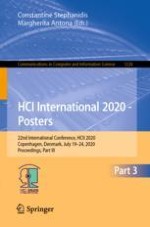The three-volume set CCIS 1224, CCIS 1225, and CCIS 1226 contains the extended abstracts of the posters presented during the 21st International Conference on Human-Computer Interaction, HCII 2020, which took place in Copenhagen, Denmark, in July 2020.*
HCII 2020 received a total of 6326 submissions, of which 1439 papers and 238 posters were accepted for publication in the pre-conference proceedings after a careful reviewing process.
The 238 papers presented in these three volumes are organized in topical sections as follows: Part I: design and evaluation methods and tools; user characteristics, requirements and preferences; multimodal and natural interaction; recognizing human psychological states; user experience studies; human perception and cognition. -AI in HCI. Part II: virtual, augmented and mixed reality; virtual humans and motion modelling and tracking; learning technology. Part III: universal access, accessibility and design for the elderly; smartphones, social media and human behavior; interacting with cultural heritage; human-vehicle interaction; transport, safety and crisis management; security, privacy and trust; product and service design.
*The conference was held virtually due to the COVID-19 pandemic.
